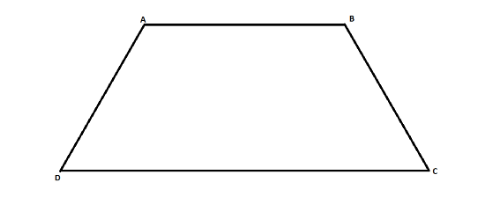
What type of quadrilateral that has no parallel sides?
Answer
507.3k+ views
Hint: In order to answer the question given above, you need to know about quadrilaterals. It is a closed shape which has four straight lines. Now, a quadrilateral may have parallel sides or no parallel sides. Examples of quadrilaterals are: Rectangle, Rhombus, trapezoid, Square, Parallelogram, etc. All of them have four sides.
Complete answer:
Before solving the above question, you need to have a clear understanding about quadrilaterals. They can be defined as a two-dimensional, closed shape which is made up of four straight sides. It includes: Square, Rectangle, Parallelogram, Trapezoid, etc.
Now, it is not necessary that a quadrilateral will have parallel sides or all the sides will be equal.
To answer the above question, we can say that a trapezium, which is also known as a trapezoid, is a type of quadrilateral with only one pair of parallel sides. In America, it usually means a quadrilateral with no parallel sides. The parallel sides of a trapezium are called bases and the non-parallel sides are called legs.
To clearly understand the concept of trapezium and non-parallel quadrilateral let us draw a diagram.

Now, we are familiar with the concept of a quadrilateral with no parallel sides.
So, in conclusion, we can say that trapezium is a quadrilateral with no parallel sides.
So, the correct answer is “trapezium”.
Note: While answering questions similar to the one given above, you need to know about the concept which has been asked in the question. In the above question, you need to have a detailed understanding of the quadrilaterals and its types to answer that trapezium is a quadrilateral with no parallel sides.
Complete answer:
Before solving the above question, you need to have a clear understanding about quadrilaterals. They can be defined as a two-dimensional, closed shape which is made up of four straight sides. It includes: Square, Rectangle, Parallelogram, Trapezoid, etc.
Now, it is not necessary that a quadrilateral will have parallel sides or all the sides will be equal.
To answer the above question, we can say that a trapezium, which is also known as a trapezoid, is a type of quadrilateral with only one pair of parallel sides. In America, it usually means a quadrilateral with no parallel sides. The parallel sides of a trapezium are called bases and the non-parallel sides are called legs.
To clearly understand the concept of trapezium and non-parallel quadrilateral let us draw a diagram.

Now, we are familiar with the concept of a quadrilateral with no parallel sides.
So, in conclusion, we can say that trapezium is a quadrilateral with no parallel sides.
So, the correct answer is “trapezium”.
Note: While answering questions similar to the one given above, you need to know about the concept which has been asked in the question. In the above question, you need to have a detailed understanding of the quadrilaterals and its types to answer that trapezium is a quadrilateral with no parallel sides.
Recently Updated Pages
Master Class 12 Business Studies: Engaging Questions & Answers for Success

Master Class 12 Economics: Engaging Questions & Answers for Success

Master Class 12 English: Engaging Questions & Answers for Success

Master Class 12 Maths: Engaging Questions & Answers for Success

Master Class 12 Social Science: Engaging Questions & Answers for Success

Master Class 12 Chemistry: Engaging Questions & Answers for Success

Trending doubts
Which places in India experience sunrise first and class 9 social science CBSE

Fill the blanks with the suitable prepositions 1 The class 9 english CBSE

Write the 6 fundamental rights of India and explain in detail

Difference Between Plant Cell and Animal Cell

What is pollution? How many types of pollution? Define it

What is the full form of pH?




